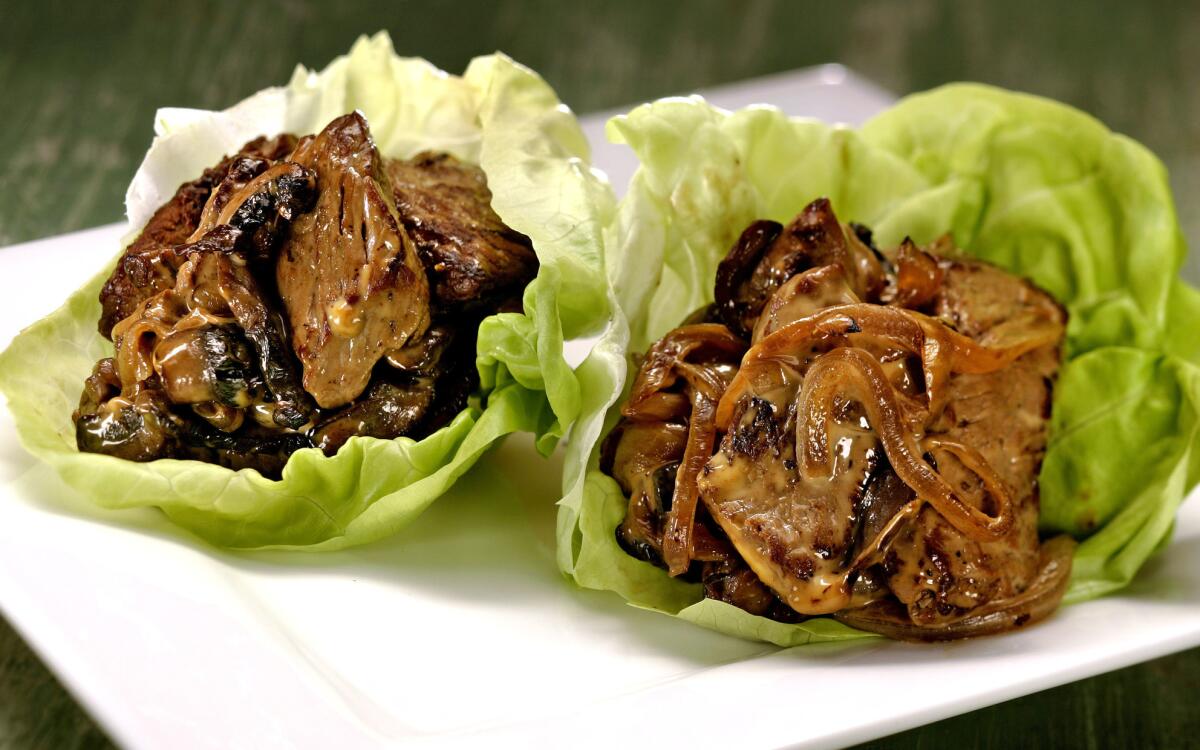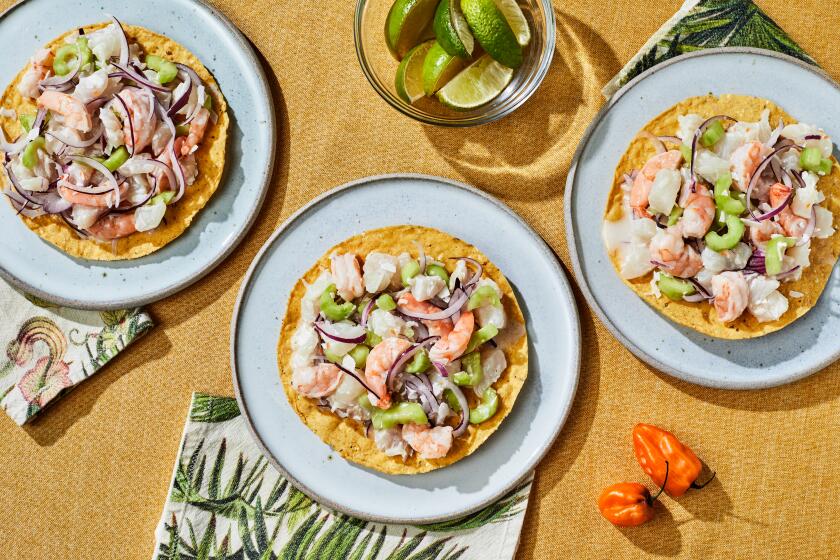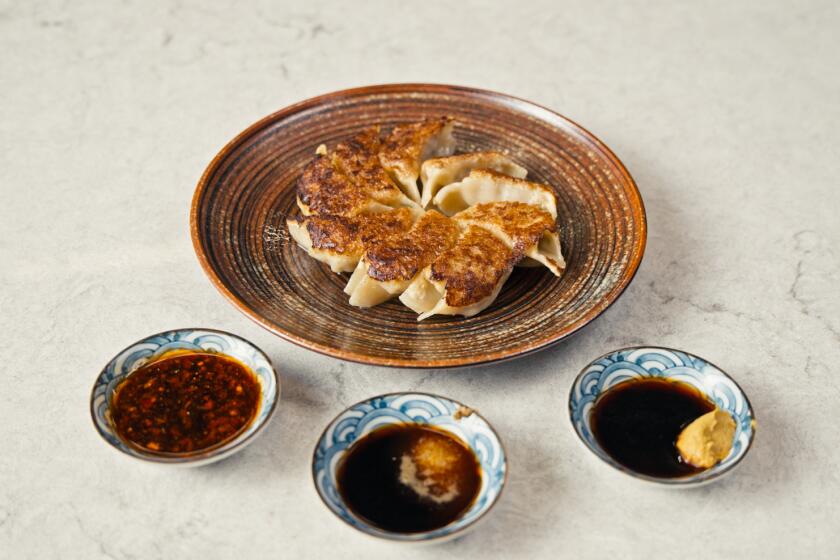Philly cheesesteak lettuce cups

Lisa Lillien considers the bowl of cocktail wieners simmered in a quick-fix barbecue sauce as if she were appraising a fine wine.
First, she swirls -- to evaluate the richness. Then, she sniffs. Tasting a spoonful of the sauce, she nods approvingly. Then comes the moment of truth: She bites into a wiener. Wrinkles up her nose. And pronounces it awful.
“The sauce is incredible,” she says. “But the dogs are rubbery.”
Standing in the middle of her Woodland Hills test kitchen, wearing jeans and a hot-pink track suit jacket, Lillien, 43, might not look like she leads one of the most rabid, devoted and willing-to-spend-money armies out there.
That would be women on a diet.
But Lillien is the creator of Hungry Girl, that bouncy cartoon character that dispenses calorie-saving recipes, health and diet tips and tell-it-like-it-is product reviews in a daily e-mail blast. Lillien started in early 2004 with roughly 70 subscribers -- all of them friends and family. Today, there are more than 750,000 subscribers, and Hungry Girl is on track to have a million by year’s end.
With the traffic has come success. Among the website’s regular advertisers are Weight Watchers and Dreyer’s light ice cream line. Her first book, “Hungry Girl: Recipes and Survival Strategies for Guilt-Free Eating in the Real World,” came out last year and shipped more than 600,000 copies. Her straight talk about calories helped drive her second book “Hungry Girl: 200 under 200” -- 200 recipes that clock in at less than 200 calories per serving -- to the No. 1 spot on the New York Times’ bestseller list earlier this year. “There is no case of ‘second-book-itis’ here,” said Matthew Shear, senior vice president and publisher of St. Martin’s Press. “The second book is selling slightly better than the first.”
She has two more books on the horizon, a TV project in the works and an endorsement deal with General Mills’ FiberOne line. (They inked a deal after learning that Hungry Girl pulverizes the cereal and uses it to add crunch to seemingly everything, whether the coating on faux-fried chicken dishes or the crust on low-cal cheesecakes.)
All told, Hungry Girl is a business that makes well over $2 million a year.
Lillien has been brainstorming with personal advisors who want her to seize this critical moment. They’d like to see her relinquish the time-consuming, hands-on control of the daily e-mail that is at the heart of her empire and instead focus on money makers such as subscription-fee-based diet plans, or expanding the advertising base.
Instead, Lillien has another plan: Taking on nutrition labels.
She wants the Food and Drug Administration to crack down on packaging that misstates -- or, more likely, understates -- the number of calories and nutrients contained within. She also wants labels to more accurately reflect the calories in real-life serving sizes, something likely to shock consumers.
Lillien recently told readers -- mainly women but also some men -- she plans to take food items to a lab for analysis to see how their calorie counts compare with the labels. She asked them to recommend products for scrutiny. Within a few hours, she says she had 400.
“People really want this information,” Lillien says. “And I’m like their crazy friend who will actually go and figure this out.”
Lillien’s e-mail blasts are wrapped in a sherbet-meets-Miami color scheme and a peppy, punny, OMG-writing style punctuated by lots of CAPS and exclamation points.
It’s a carefree, bestest girlfriend style that she honed over a career that began with the Long Island native’s first job out of college: editor in chief for Tutti Frutti, a Tiger Beat kind of teen celebrity magazine. She later moved into TV, working as executive producer for TV Land Online and director of convergence development at Nickelodeon Online.
Alongside her career successes, Lillien found herself constantly struggling with an extra 20 or so pounds. Then, in 2002, “I just said ‘Enough!’ ” She lost the weight by walking on her treadmill, cleaning up her diet and taking a long, hard look at trigger foods -- like potato chips -- that always seemed to send her diet into a tailspin. She also played mad scientist in the kitchen, concocting low-cal snacks and substitutes for foods that always gave her trouble.
When she began sharing her results with family and friends, they demanded more.
“I knew I was on to something,” she says.
She decided to quit her job and see if she could turn Hungry Girl into a business. “I told my husband, ‘If after a year, this is just an expensive hobby, I will go back to work.’ ” (Her husband, Dan Schneider, created and executive produces the 2-year-old Nickelodeon hit “iCarly,” and the couple live in Encino.)
Hungry Girl quickly built a following. “We’ve never spent one penny to advertise it,” says Lillien, who adds that she chose an e-mail blast because she wanted people to want it, to sign up for it, to pass it along -- not just trip over it on the Internet. As the subscribers grew, so did Lillien’s staff. She now has nine employees, including a graphic designer, recipe developers and researchers. But the essence is still Hungry Girl.
“She really brings humor to it, and you can totally relate to her,” says Danica Pike of Fairfield, Calif., who has been a Hungry Girl subscriber for more than four years and appreciates Lillien’s easy recipes and honest reviews. “She’s not like other diet blogs that will just plug any product.”
With Americans reportedly spending well over $35 billion a year on weight-loss products, the niche world of low-calorie snack foods clamors for Lillien’s stamp of approval. A flood of new products arrives on her doorstep each week in the hopes of getting an e-mail shout-out.
Lillien’s clout comes from a personal code of ethics. She does not accept payment in exchange for a review or mention in her daily e-mail. And she recommends or accepts advertising dollars only from products she personally uses.
But if she endorses your product, well . . . let Keith Belling tell it.
Belling, co-founder and chief executive of PopChips -- a baked alternative to fried potato chips -- sat down at his desk one morning to find his in-box jampacked with product requests.
“I’m like, ‘What is going on here?’ It was Hungry Girl.” And a rave review. Belling said he used the e-mails to better gauge the potential audience for PopChips and called or contacted nearly everyone who wrote. He said he was struck by their diversity. Young. Old. Professionals. College students. Kids in high school. Stay-at-homes.
Belling would not discuss how the Hungry Girl stamp of approval has affected sales, but he said the endorsement is “priceless” because a traditional ad campaign could never reach such a swath.
Lillien, who looks disconcertingly like her cartoon image sprung to life, including the feline-green eyes, gleaming white teeth and swing-y brown locks, is curled up in a chair in her Hungry Girl office. It’s really the master bedroom suite of a rental unit in a posh apartment complex. Lillien set up shop in the unusual digs because of a floor-to-ceiling pantry for storing those products that keep arriving, and a spacious kitchen that lends itself to recipe testing.
Critics say that her recipes may be low-cal, but that doesn’t mean they are healthful. Wrote one online commenter: “I am not a fan of Hungry Girl. She advocates processed foods in landfill-filling single serving packages, Splenda, cooking spray instead of olive oil etc. It’s the same dieting nonsense that has made the U.S. fatter each year. . . .”
Lillien argues that her critics are missing the point. She says Hungry Girl subscribers are well-versed about nutrition -- they don’t need to be lectured. Instead, they’re looking for low-calorie ways to scratch a snack itch without blowing their diets.
Others applaud such a balanced approach: “Of course, the best diet is whole foods, fresh fruits and vegetables, and grains, but this can help people who have cravings stay on track,” says Angela Ginn-Meadow, a spokeswoman and nutritionist with the American Dietetic Assn.
Lillien’s reaction is the same to both the criticism and the lobbying of those who push her to expand Hungry Girl in new directions.
The way she sees it, her credibility, her voice is all she has.
And if she were to nibble away at that -- by handing the e-mails over to someone else, or taking advertising dollars for products she wouldn’t use, or putting her name on a fee-based diet plan -- she’d run the risk of turning off her friends, which is how she sees her followers.
“People would see right through that,” she says. “That would water down the power of the brand.”
She added: “[Advisors] keep telling me, ‘One day you’ll need to decide what you really want to focus on.’ But they don’t understand that that’s exactly what I’m doing.”
Slice the fillet crosswise into thin strips about one-eighth inch thick. Set aside.
Spray a medium pan with nonstick spray and heat over medium-high heat. Add the mushrooms and onions and cook, stirring occasionally, until the onions are slightly browned, about 5 minutes. Remove from heat to a small bowl and set aside.
Re-spritz the pan with nonstick spray. Cook the fillet strips over medium-high heat until browned on each side, 1 to 1 1/2 minutes on each side.
Break the cheese slice into small strips, place on top of the meat -- still in the pan -- and continue to cook until the cheese has melted slightly, less than 1 minute.
Remove from heat and mix the cheesy beef strips in with the mushrooms and onions. Serve in the lettuce “cups.”
Get our Cooking newsletter.
Your roundup of inspiring recipes and kitchen tricks.
You may occasionally receive promotional content from the Los Angeles Times.
















